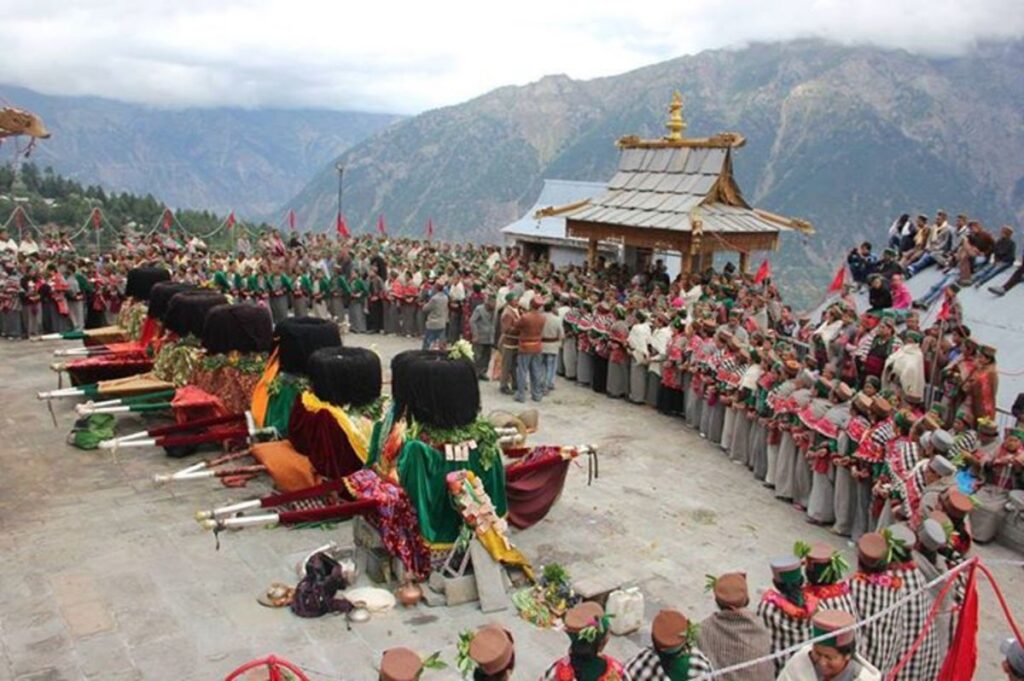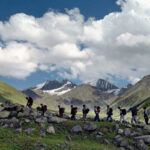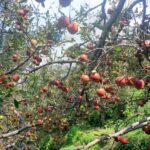Introduction
Beyond the snow-capped peaks and apple orchards, Kinnaur holds a treasure that often goes unseen — its tribal communities, vibrant festivals, and a deep-rooted culture that blends Hinduism and Tibetan Buddhism in the most beautiful harmony.
In this blog, we’ll step away from just sightseeing and step into the lives, rituals, and rhythm of the Kinnauri people. Because to truly know a place, one must know its people.

Who Are the People of Kinnaur?
- Kinnaur is home to indigenous tribal communities recognized under India’s Scheduled Tribes
- The Kinnauri people are known for their hospitality, hardworking nature, and deep spiritual beliefs
- Local dialects include Kinnauri, Hindi, and Tibetan-influenced languages
- Their attire includes woolen shawls, silver jewelry, and the iconic green Kinnauri cap (topi)
- Agriculture is central — especially apples, rajma, barley, and chilgoza (pine nuts)
Spiritual Beliefs and Practices

- Kinnauris follow a unique syncretism of Hinduism and Tibetan Buddhism
- They believe in Dewa (gods), Buru (spirits), and ancestral deities
- Each village has a local deity or guardian spirit
- Temples often feature both Hindu-style idols and Buddhist thangkas or wheels
📿 Interesting Fact: The deity system is so strong that even festivals and decisions are guided through oracle readings or priestly interpretation.
Major Festivals of Kinnaur



🔹 Fulaich Festival (Festival of Flowers)
- Held in September, especially in Kalpa and Sangla
- Celebrates ancestors and blooming of alpine flowers
- Locals go to nearby forests to collect flowers and then offer them at temples
- Includes masked dances, folk music, and communal feasts
- Symbolizes gratitude to nature and forefathers
🔹 Losar (Tibetan New Year)
- Celebrated in February or March
- Involves cleaning homes, lighting lamps, and praying for prosperity
- Homes are decorated with butter lamps and prayer flags
- Features traditional Kinnauri dishes, dances, and visits to monasteries
- Similar to Tibetan Losar celebrated in nearby Spiti and Lahaul
🔹 Dakhraini
- Held in July in lower Kinnaur villages like Nichar
- Involves trance rituals, where oracles speak through possessed villagers
- Masked dances, animal sacrifices, and singing folk ballads
- Offers a raw, intense glimpse into the animistic beliefs of the region
🔹 Phagli
- Winter festival celebrated in February, especially around Kalpa
- Locals wear devil masks and animal costumes
- A mix of pagan, Buddhist, and Hindu practices
- Drives away evil spirits and welcomes spring
Music and Dance in Kinnaur

- Kinnauri Nati is the most popular folk dance — slow and graceful with circular movements
- Instruments used: flute, drum (dhol), shehnai, bugchu
- Songs tell stories of gods, harvests, love, and war
- Music is an integral part of life, from celebrations to daily work
Architecture and Lifestyle
| Feature | Description |
|---|---|
| Houses | Made of stone and wood, sloped slate roofs |
| Temples | Blend of Hindu and Tibetan Buddhist styles |
| Villages | Compact, self-sufficient, scenic locations |
| Dress | Woolen wear, green caps, silver ornaments |
| Food | Based on barley, buckwheat, rajma, and potatoes |
✅ Locals live in harmony with nature, grow their own food, and follow seasonal farming cycles
Local Cuisine
- Siddu – Steamed bread with walnut or poppy seed stuffing
- Chilra – Himachali pancakes
- Thukpa – Noodle soup borrowed from Tibetan cuisine
- Chha Gosht – Spiced lamb curry (in some parts)
- Apricot jam and chutneys
- Locally brewed apple wine and arak (barley alcohol)
✅ Most dishes are homegrown, organic, and deeply nourishing
Cultural Experiences for Travelers
✅ Attend a village festival (Fulaich or Losar)
✅ Stay in a Kinnauri homestay — share meals, listen to stories
✅ Visit local temples and monasteries (Kamru, Charang, Moorang)
✅ Buy handmade Kinnauri shawls, woolens, and silver jewelry
✅ Learn about local agriculture and traditional cooking
Things to Respect as a Tourist
- Always ask before photographing people or temples
- Dress modestly in villages and religious sites
- Avoid loud music or behavior in spiritual places
- Respect local customs (no leather inside temples, etc.)
- Do not interrupt or comment on ritual practices
Summary
While the world sees Kinnaur for its landscapes, the true soul of the region lies in its people, rituals, and rhythms. The music of the dhol, the scent of juniper smoke, and the joy of a Fulaich celebration — this is the real magic of Kinnaur.
Planning to Experience Tribal Kinnaur?
Step into their world, not as a tourist — but as a respectful guest. You’ll leave with more than photos — you’ll carry stories, smiles, and a slice of Himalayan soul.
✨ Share your stories with #TribalKinnaurDiaries!
- Latest News Headlines – Stay Informed, Wherever You Are
- Global Weather Watch
- 🤖 The Rise of AI Companions: Are Virtual Friends Replacing Real Ones?
- 🧠 Neuromorphic Chips: Mimicking the Brain to Supercharge AI
- Space Tourism in 2025: From Dream to Reality
- AI in Healthcare: Diagnosing Disease Faster Than Doctors?
- Habban Valley – Hidden Paradise in Sirmaur, Himachal Pradesh
- Nohradhar – Gateway to Churdhar
- Haripurdhar – A Historic Fort and Spiritual Escape in Sirmaur, Himachal Pradesh
- Rajgarh – The Peach Bowl of Himachal Pradesh
- Shillai – An Offbeat Escape in the Mountains of Sirmaur, Himachal
- Paonta Sahib – A Sacred Sikh Pilgrimage Town on the Yamuna River
- Churdhar Trek – Conquering the Highest Peak of the Shivaliks
- Renuka Ji Lake – Sacred Waters & Serene Views in Sirmaur
- Peer Nigaha – Mystical Sufi Shrine on a Hilltop in Una
- Dhussara Mahadev – A Hidden Shiva Temple in the Forests of Una
- Pong Dam Wetlands – A Birdwatcher’s Paradise in Una
- Dera Baba Bharbhag Singh – Spiritual Healing & Annual Fair
- Kaleshwar Mahadev Temple – Cave Shrine Beside the Beas
- Chintpurni Temple – The Shakti Peetha of Wish Fulfillment
- Markandeya Rishi Temple – Mythology & Forest Serenity in Bilaspur/Hamirpur Border
- Nadaun – Riverside Ghats, History & Hidden Temples in Hamirpur
- Awah Devi Temple – Sunrise Views & Spiritual Energy in Hamirpur
- Sujanpur Tira Fort & Temples – A Historical Riverside Town in Hamirpur
- Baba Balak Nath Temple – Faith, Devotion & Eternal Blessings in Hamirpur



